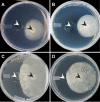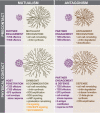Molecular Dialogues between Early Divergent Fungi and Bacteria in an Antagonism versus a Mutualism
- PMID: 32900811
- PMCID: PMC7482071
- DOI: 10.1128/mBio.02088-20
Molecular Dialogues between Early Divergent Fungi and Bacteria in an Antagonism versus a Mutualism
Abstract
Fungal-bacterial symbioses range from antagonisms to mutualisms and remain one of the least understood interdomain interactions despite their ubiquity as well as ecological and medical importance. To build a predictive conceptual framework for understanding interactions between fungi and bacteria in different types of symbioses, we surveyed fungal and bacterial transcriptional responses in the mutualism between Rhizopus microsporus (Rm) (ATCC 52813, host) and its Mycetohabitans (formerly Burkholderia) endobacteria versus the antagonism between a nonhost Rm (ATCC 11559) and Mycetohabitans isolated from the host, at two time points, before and after partner physical contact. We found that bacteria and fungi sensed each other before contact and altered gene expression patterns accordingly. Mycetohabitans did not discriminate between the host and nonhost and engaged a common set of genes encoding known as well as novel symbiosis factors. In contrast, responses of the host versus nonhost to endobacteria were dramatically different, converging on the altered expression of genes involved in cell wall biosynthesis and reactive oxygen species (ROS) metabolism. On the basis of the observed patterns, we formulated a set of hypotheses describing fungal-bacterial interactions and tested some of them. By conducting ROS measurements, we confirmed that nonhost fungi increased production of ROS in response to endobacteria, whereas host fungi quenched their ROS output, suggesting that ROS metabolism contributes to the nonhost resistance to bacterial infection and the host ability to form a mutualism. Overall, our study offers a testable framework of predictions describing interactions of early divergent Mucoromycotina fungi with bacteria.IMPORTANCE Animals and plants interact with microbes by engaging specific surveillance systems, regulatory networks, and response modules that allow for accommodation of mutualists and defense against antagonists. Antimicrobial defense responses are mediated in both animals and plants by innate immunity systems that owe their functional similarities to convergent evolution. Like animals and plants, fungi interact with bacteria. However, the principles governing these relations are only now being discovered. In a study system of host and nonhost fungi interacting with a bacterium isolated from the host, we found that bacteria used a common gene repertoire to engage both partners. In contrast, fungal responses to bacteria differed dramatically between the host and nonhost. These findings suggest that as in animals and plants, the genetic makeup of the fungus determines whether bacterial partners are perceived as mutualists or antagonists and what specific regulatory networks and response modules are initiated during each encounter.
Keywords: Mycetohabitans; Rhizopus microsporus; cell wall remodeling; innate immunity; reactive oxygen species.
Copyright © 2020 Lastovetsky et al.
Figures



Similar articles
-
Lipid metabolic changes in an early divergent fungus govern the establishment of a mutualistic symbiosis with endobacteria.Proc Natl Acad Sci U S A. 2016 Dec 27;113(52):15102-15107. doi: 10.1073/pnas.1615148113. Epub 2016 Dec 12. Proc Natl Acad Sci U S A. 2016. PMID: 27956601 Free PMC article.
-
Bacterial endosymbionts influence host sexuality and reveal reproductive genes of early divergent fungi.Nat Commun. 2017 Nov 29;8(1):1843. doi: 10.1038/s41467-017-02052-8. Nat Commun. 2017. PMID: 29184190 Free PMC article.
-
A TAL effector-like protein of an endofungal bacterium increases the stress tolerance and alters the transcriptome of the host.Proc Natl Acad Sci U S A. 2020 Jul 21;117(29):17122-17129. doi: 10.1073/pnas.2003857117. Epub 2020 Jul 6. Proc Natl Acad Sci U S A. 2020. PMID: 32632014 Free PMC article.
-
Biology of Fungi and Their Bacterial Endosymbionts.Annu Rev Phytopathol. 2018 Aug 25;56:289-309. doi: 10.1146/annurev-phyto-080417-045914. Annu Rev Phytopathol. 2018. PMID: 30149793 Review.
-
Inter-kingdom encounters: recent advances in molecular bacterium-fungus interactions.Curr Genet. 2009 Jun;55(3):233-43. doi: 10.1007/s00294-009-0241-2. Epub 2009 Apr 1. Curr Genet. 2009. PMID: 19337734 Review.
Cited by
-
Detecting and characterizing new endofungal bacteria in new hosts: Pandoraea sputorum and Mycetohabitans endofungorum in Rhizopus arrhizus.Front Microbiol. 2024 Feb 29;15:1346252. doi: 10.3389/fmicb.2024.1346252. eCollection 2024. Front Microbiol. 2024. PMID: 38486702 Free PMC article.
-
Sequencing the Genomes of the First Terrestrial Fungal Lineages: What Have We Learned?Microorganisms. 2023 Jul 18;11(7):1830. doi: 10.3390/microorganisms11071830. Microorganisms. 2023. PMID: 37513002 Free PMC article. Review.
-
Transcription activator-like effector protects bacterial endosymbionts from entrapment within fungal hyphae.Curr Biol. 2023 Jul 10;33(13):2646-2656.e4. doi: 10.1016/j.cub.2023.05.028. Epub 2023 Jun 9. Curr Biol. 2023. PMID: 37301202 Free PMC article.
-
Turning antagonists into allies: Bacterial-fungal interactions enhance the efficacy of controlling Fusarium wilt disease.Sci Adv. 2025 Feb 14;11(7):eads5089. doi: 10.1126/sciadv.ads5089. Epub 2025 Feb 12. Sci Adv. 2025. PMID: 39937904 Free PMC article.
-
Transcriptional Profiles of a Foliar Fungal Endophyte (Pestalotiopsis, Ascomycota) and Its Bacterial Symbiont (Luteibacter, Gammaproteobacteria) Reveal Sulfur Exchange and Growth Regulation during Early Phases of Symbiotic Interaction.mSystems. 2022 Apr 26;7(2):e0009122. doi: 10.1128/msystems.00091-22. Epub 2022 Mar 16. mSystems. 2022. PMID: 35293790 Free PMC article.
References
Publication types
MeSH terms
Supplementary concepts
LinkOut - more resources
Full Text Sources
Medical
Molecular Biology Databases

